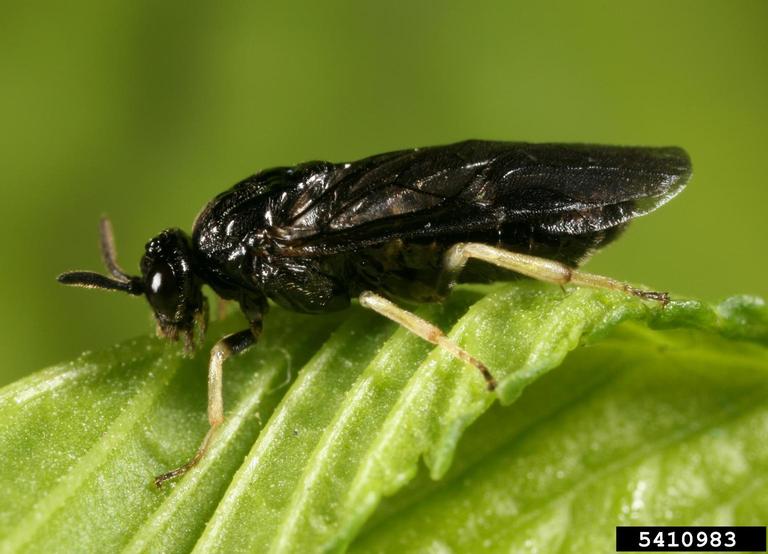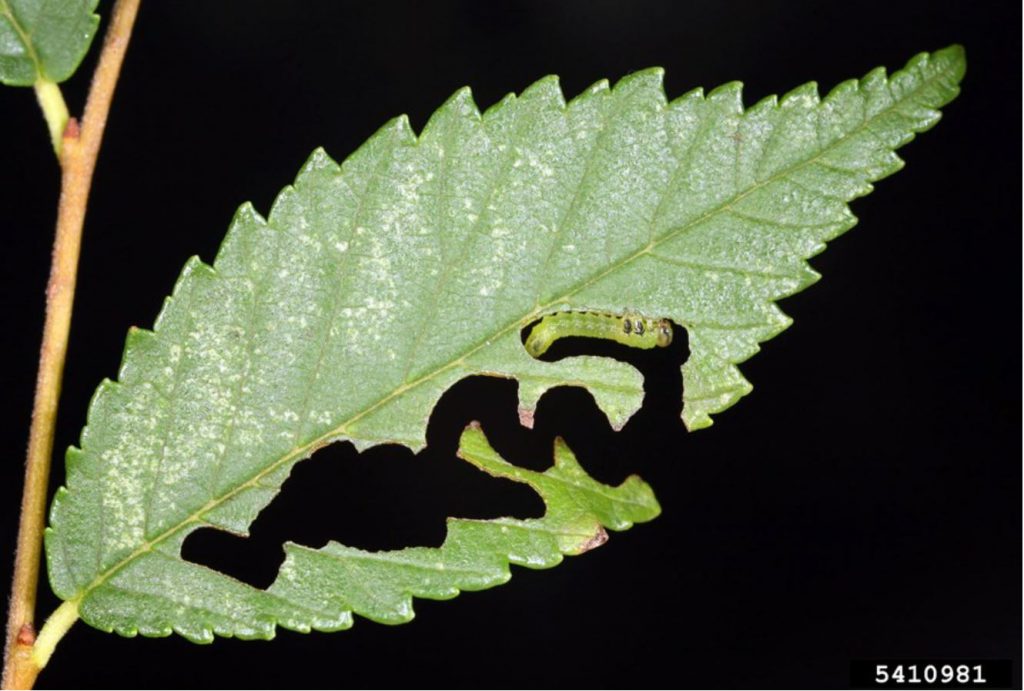
Adult EZS on an elm leaf where they lay their eggs. Photo: Gyorgy Csoka, Hungary Forest Research Institute, Bugwood.org.
By: Sarah Sinon, Research Analyst Intern
With its signature feeding pattern, the elm zigzag sawfly (EZS; Aproceros leucopoda) has begun its invasion into North America. The first confirmed detection of EZS in North America occurred in July, 2020 near Saint-Martine, Quebec by a citizen scientist who reported the signature ‘zigzag’ feeding pattern on the iNaturalist.ca application. The sighting was later confirmed by experts from the Canadian Food Inspection Agency.

EZS larva feeding in the signature ‘zigzag’ pattern on an elm leaf. Photo: Gyorgy Csoka, Hungary Forest Research Institute, Bugwood.org.
EZS is an invasive forest pest native to Asia. Outside of its native range, EZS is known to cause severe defoliation of elm trees (Ulmus spp.). All species of elm trees native to North America are at risk, as well as the native elm-browsing insects which are out-competed by EZS. Although EZS has not proven to be a leading cause in tree mortality, continuous feeding can cause significant branch die-back and crown thinning, and can eventually lead to the weaking and increased vulnerability of the tree. This has potential to further exacerbate the population decline of elm trees that are already vulnerable due to Dutch elm disease (Ophiostoma ulmi).
How does EZS spread? Adult EZS can travel up to 90 km through flight but have been known to hitchhike on vehicles, or on elm products travelling much greater distances than would be possible by natural movement. Adult EZS lay eggs in the serrated edge of the elm leaf, and have been known to produce six generations in a year. Such a rapid life cycle is of concern, as is their ability to withstand temperatures as low as –30 °C which leaves much of Canada susceptible to this forest pest. Combined with their tiny size, and relatively undetectable presence in low densities, EZS has the potential to impact Canada’s biodiversity.
With only a single confirmed detection of this species in North America, EZS is in the early phase of species arrival. Preventing this species from expanding across the continent starts with early detection and consistent monitoring of elm trees. Everyone in Canada plays an important role in detecting, reporting, and promoting invasive species awareness. Protect Canada’s elm trees by keeping an eye out for this signature ‘zigzag’ feeding pattern when out enjoying our nation’s natural beauty. If you think you’ve seen EZS, please report your sighting – record where you saw the species, and if possible, take photos of the species or suspected leaf damage. To submit a report directly to the Canadian Food Inspections Agency visit inspection.gc.ca. For more information on reporting a sighting, visit invasivespeciescentre.ca.
The Invasive Species Centre (ISC) prevents the introduction and spread of invasive species in Canada by connecting stakeholders with knowledge and technology. Incorporated as a non-for-profit in 2011, ISC is a hub for collaboration and knowledge sharing. Through species profiles, monthly webinars, best management practices, management services, fact sheets, and blog posts such as this one, ISC has a vision of a Canada where land and water are protected from invasive species.
